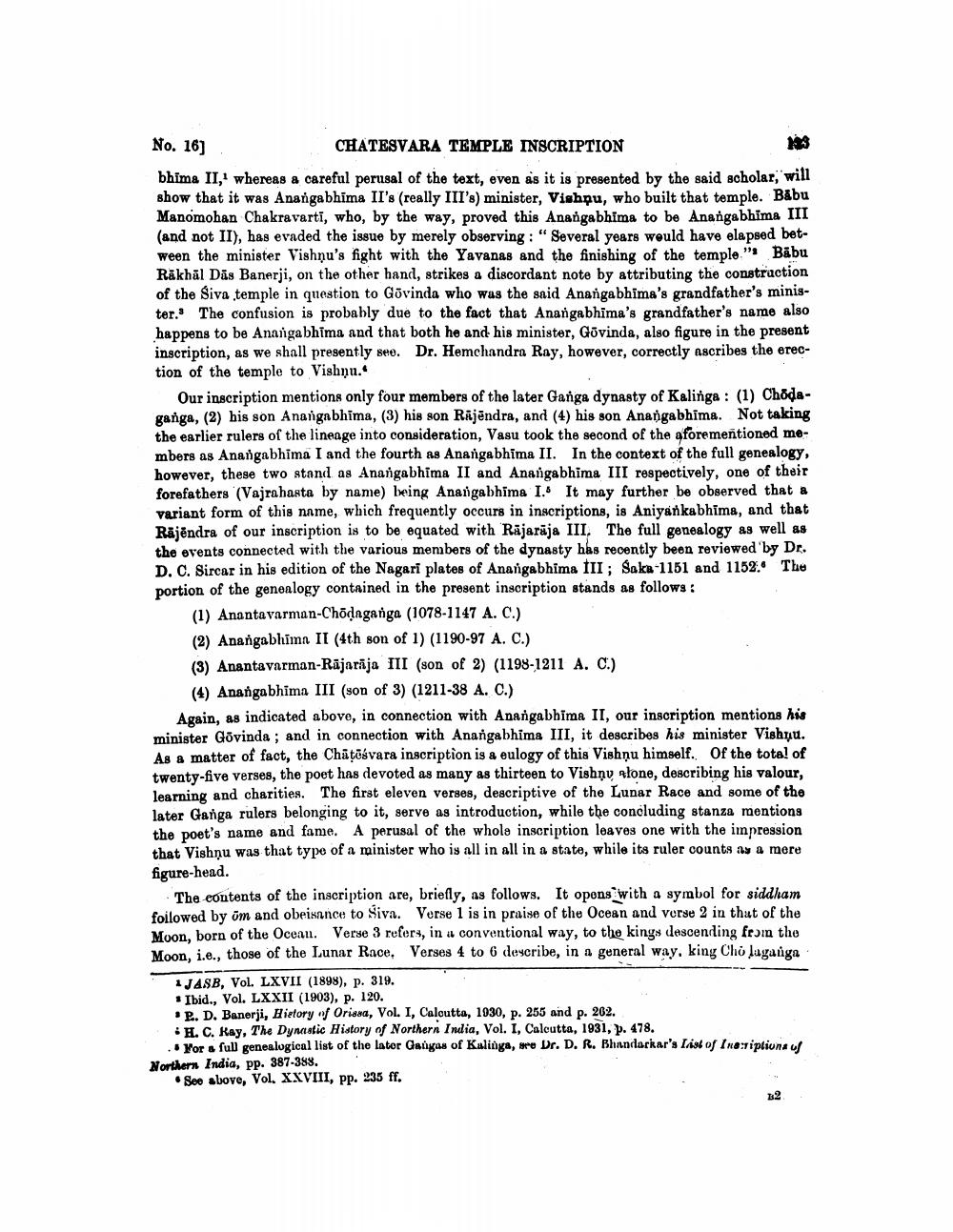________________
123
No. 16]
CHATESVARA TEMPLE INSCRIPTION
bhima II,1 whereas a careful perusal of the text, even as it is presented by the said scholar, will show that it was Anangabhima II's (really III's) minister, Vishnu, who built that temple. Bābu Manomohan Chakravarti, who, by the way, proved this Anangabhima to be Anangabhima III (and not II), has evaded the issue by merely observing: "Several years would have elapsed between the minister Vishnu's fight with the Yavanas and the finishing of the temple." Bābu Rākhāl Das Banerji, on the other hand, strikes a discordant note by attributing the construction of the Siva temple in question to Govinda who was the said Anangabhima's grandfather's minister. The confusion is probably due to the fact that Anangabhima's grandfather's name also happens to be Anangabhima and that both he and his minister, Govinda, also figure in the present inscription, as we shall presently see. Dr. Hemchandra Ray, however, correctly ascribes the erection of the temple to Vishnu.
Our inscription mentions only four members of the later Ganga dynasty of Kalinga : (1) Chōdaganga, (2) his son Anangabhima, (3) his son Rajendra, and (4) his son Anangabhima. Not taking the earlier rulers of the lineage into consideration, Vasu took the second of the aforementioned members as Anangabhima I and the fourth as Anangabhīma II. In the context of the full genealogy, however, these two stand as Anangabhima II and Anangabhima III respectively, one of their forefathers (Vajrahasta by name) being Anangabhima I. It may further be observed that a variant form of this name, which frequently occurs in inscriptions, is Aniyankabhima, and that Rajendra of our inscription is to be equated with Rajaraja III. The full genealogy as well as the events connected with the various members of the dynasty has recently been reviewed by Dr. D. C. Sircar in his edition of the Nagari plates of Anangabhima III; Saka-1151 and 1152. The portion of the genealogy contained in the present inscription stands as follows:
(1) Anantavarman-Chōdaganga (1078-1147 A. C.)
(2) Anangabhima II (4th son of 1) (1190-97 A. C.)
(3) Anantavarman-Rajaraja III (son of 2) (1198-1211 A. C.)
(4) Anangabhima III (son of 3) (1211-38 A. C.)
Again, as indicated above, in connection with Anangabhima II, our inscription mentions his minister Govinda; and in connection with Anangabhima III, it describes his minister Vishnu. As a matter of fact, the Chatesvara inscription is a eulogy of this Vishnu himself. Of the total of twenty-five verses, the poet has devoted as many as thirteen to Vishnu alone, describing his valour, learning and charities. The first eleven verses, descriptive of the Lunar Race and some of the later Ganga rulers belonging to it, serve as introduction, while the concluding stanza mentions the poet's name and fame. A perusal of the whole inscription leaves one with the impression that Vishnu was that type of a minister who is all in all in a state, while its ruler counts as a mere figure-head.
The contents of the inscription are, briefly, as follows. It opens with a symbol for siddham followed by um and obeisance to Siva. Verse 1 is in praise of the Ocean and verse 2 in that of the Moon, born of the Ocean. Verse 3 refers, in a conventional way, to the kings descending from the Moon, i.e., those of the Lunar Race, Verses 4 to 6 describe, in a general way, king Cho laganga
1JASB, Vol. LXVII (1898), p. 319.
Ibid., Vol. LXXII (1903), p. 120.
P. D. Banerji, History of Orissa, Vol. I, Calcutta, 1930, p. 255 and p. 202.
H. C. Kay, The Dynastic History of Northern India, Vol. I, Calcutta, 1931, p. 478.
For a full genealogical list of the later Gangas of Kalinga, see Dr. D. R. Bhandarkar's List of Inscriptions of Northern India, pp. 387-388.
See above, Vol. XXVIII, pp. 235 ff.
12




